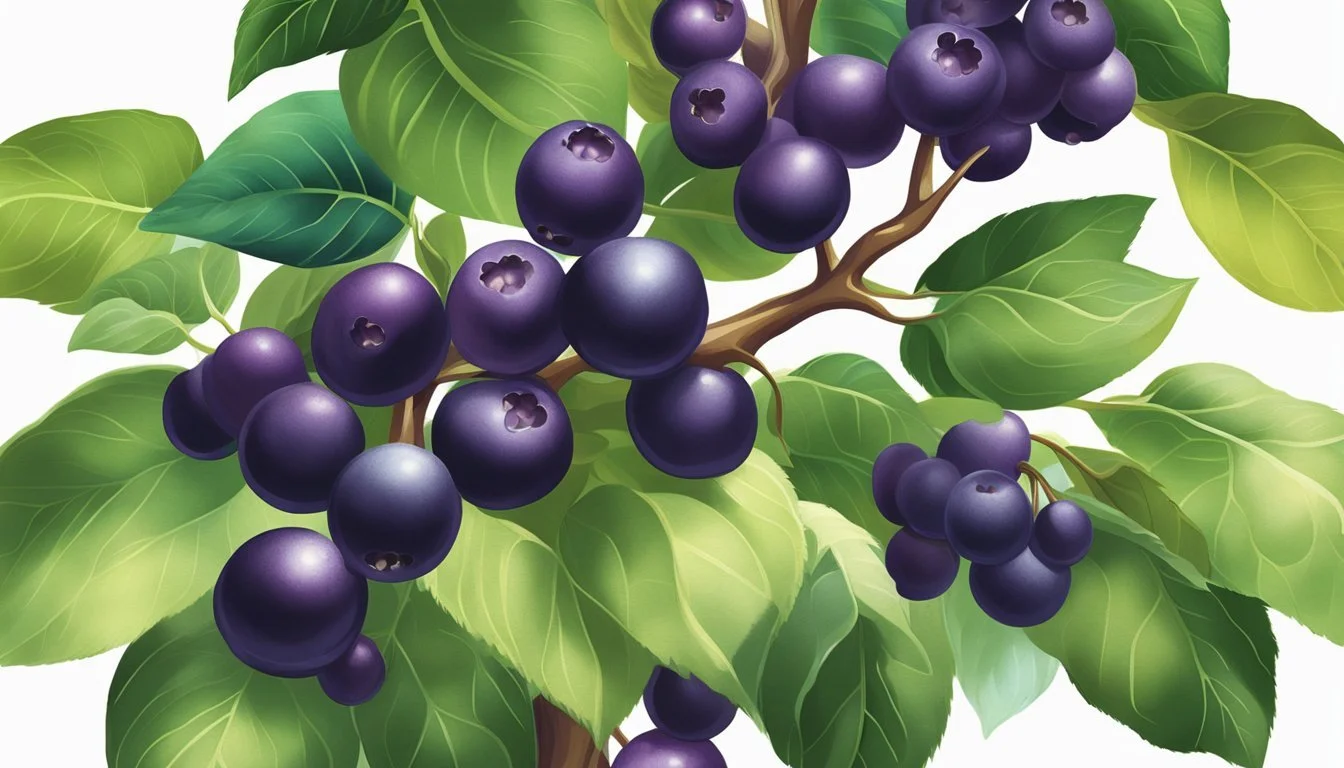The Antioxidant Power of Maqui Berry
Unveiling Mapuche Traditions
The Maqui berry, scientifically known as Aristotelia chilensis, is an indigenous fruit to the temperate rainforests of Chile and Argentina and a staple in the diet of the Mapuche, an indigenous community inhabiting these regions. Revered for centuries by the Mapuche for its medicinal properties, the berry's deep purple hue is indicative of its high antioxidant content, which surpasses many of its better-known counterparts. These antioxidants play a critical role in neutralizing free radicals, unstable molecules that can cause cell damage and lead to various chronic diseases.
Incorporated traditionally in the Mapuche diet both for its nutritional value and healing qualities, the Maqui berry is a reflection of their deep-rooted understanding of the natural synergy between health and the environment. Modern science affirms the Mapuche's traditional use of Maqui berries, highlighting their anti-inflammatory and cardioprotective effects, among other health benefits. Studies indicate the potential of this superfruit in promoting wellness, as its potent antioxidants, particularly anthocyanins and polyphenols, help support the body's defense system against oxidative stress.
While the Maqui berry is becoming increasingly popular in health-conscious circles around the globe, its cultivation and harvest remain largely true to the time-tested methods of the Mapuche people. The sustainable practices inherent in the Mapuche tradition not only preserve the purity of the fruit but also ensure the longevity of the region's delicate ecosystems. As the world turns its attention to this 'superberry,' it is essential to honor and recognize the Mapuche culture that has sustained and cherished the Maqui berry for generations.
Maqui Berry, celebrated for its antioxidant power, has captivated health enthusiasts with its remarkable health benefits. This potent berry has been revered for its high levels of antioxidants, which contribute to its potential to promote overall health and well-being. When combined with cardamom and ashwagandha, Maqui Berry offers a holistic approach to supporting a healthy lifestyle, reflecting its enduring appeal in modern wellness practices.
Furthermore, the addition of sea buckthorn, milk thistle, and beetroot further complements the antioxidant potential of Maqui Berry, contributing to its reputation as a versatile and effective natural remedy. Additionally, the incorporation of chia seeds and goldenseal into wellness practices alongside Maqui Berry has expanded the spectrum of potential health benefits, underscoring the enduring appeal of this remarkable superfruit.
In conclusion, Maqui Berry continues to be celebrated for its antioxidant power and potential to support vitality and holistic well-being. Whether combined with cardamom, ashwagandha, sea buckthorn, milk thistle, beetroot, chia seeds, or goldenseal, Maqui Berry remains a symbol of health and wellness, embodying the rich heritage of natural health practices.
Cultural Significance
The Maqui berry (Aristotelia chilensis) holds a venerable position within the traditions of the Mapuche people, deeply intertwined with the natural heritage of Chile and Argentina.
Mapuche Tradition
The Mapuche Indians – indigenous inhabitants of South-Central Chile and South-Western Argentina – have long celebrated the Maqui berry for its vital role in their diet and medicinal practices. Culturally, the Maqui berry is not just a food source but a symbol of health and vitality, revered for its purported healing properties and connection to the land.
Health: Revered for its potential to strengthen the body and enhance stamina.
Heritage: Integrated into Mapuche mythology and used in traditional ceremonies.
Origin: Chile and Argentina
Native to the temperate rainforests of southern Chile and Argentina, the Aristotelia chilensis thrives in the Patagonia region.
Patagonia: Represents the pristine and lush environment where the Maqui berry grows wild.
Biodiversity: The berry's natural habitat underscores the rich botanical diversity of the region.
The link between the Maqui berry and the Mapuche culture extends deep into the history of these South American territories, symbolizing a bond between the people and the bounty of the land they hold sacred.
Nutritional Profile
Maqui berry, a fruit that has been a staple in the Mapuche tradition, boasts an exceptional nutritional composition. This profile is rich in specific nutrients and unique bioactive compounds that contribute to the berry's potent antioxidant capability.
Key Nutrients
Maqui berry is a nutrient-dense fruit containing significant levels of vitamin C, which is pivotal for the maintenance of immune system function and skin health. In addition to vitamin C, it provides essential minerals and dietary fiber contributing to the overall nutritional value of the berry.
Unique Bioactive Compounds
The maqui berry is particularly celebrated for its high concentration of antioxidants, such as polyphenols and anthocyanins, which are responsible for the berry's deep purple hue. These compounds, especially the anthocyanins like delphinidin, exhibit strong antioxidative properties.
Phenolic compounds are abundant in maqui berry, with a high total phenolic content that is instrumental in combating oxidative stress in the body. Phenolic acids, including gallic acid, are a component of these phenolic compounds. Flavonols like quercetin and myricetin are also present, further enhancing its antioxidative capacity and reinforcing the berry's role as a powerful ally against free radicals.
Health Benefits
The Maqui Berry is celebrated for its robust antioxidant power, offering a range of health benefits that stem from its ability to counteract oxidative stress and support various bodily functions, from blood sugar regulation to skin protection.
Combating Oxidative Stress
Maqui berries are rich in antioxidants, which have the capacity to neutralize harmful free radicals. This fruit's antioxidant activity plays a crucial role in mitigating oxidative stress, which is implicated in the aging process and the development of diseases.
Inflammatory Diseases Prevention
The anti-inflammatory properties found in Maqui Berry can help in reducing chronic inflammation, a known factor in a variety of inflammatory diseases. Its potent compounds, like anthocyanins, assist in modulating the inflammatory process.
Regulating Blood Sugar
Individuals with diabetes may find maqui berry beneficial due to its influence on blood sugar levels. It aids in the normalization of fasting blood glucose, which is especially relevant for those with type 2 diabetes or prediabetes.
Supporting Heart Health
Consuming Maqui Berry supports heart health by helping to maintain normal cholesterol levels. The antioxidants in Maqui Berry contribute to cardiovascular protection by fighting oxidative stress, which if uncontrolled, can lead to heart disease.
Protective Properties for Skin
The high antioxidant content in Maqui Berry is essential for skin health, including protection against UV radiation and potential anti-aging effects. These berries also promote DNA repair, which is crucial for maintaining skin integrity and youthfulness.
Comparisons to Other Berries
The antioxidant capacity of maqui berry often shines when evaluated against other well-known counterparts, particularly blueberries, and within the broader superfruit category.
Maqui vs. Blueberries
Antioxidant Content: Maqui berries boast a remarkable antioxidant content, surpassing that of blueberries. This is largely due to their high levels of anthocyanins and polyphenols.
Nutrient Maqui Berry Blueberry Anthocyanins High Moderate Polyphenols High Moderate
While blueberries are celebrated for their health benefits and antioxidant properties, maqui berries contain approximately 300% more antioxidants—a significant difference that underscores maqui's potency.
Maqui in the Superfruit Category
Within the superfruit category, maqui berries stand out due to their expansive antioxidant capacity. The term superfruit is attributed to fruits with a dense nutrient profile that includes vitamins, minerals, and antioxidants, which contribute to various health benefits.
Maqui’s total polyphenolic content is substantial, positioning it prominently among superfruits. This high concentration of polyphenols may contribute to anti-inflammatory properties and other health benefits, although it should be noted that dietary balance and overall lifestyle are critical factors in wellness.
Consumption and Uses
Maqui berry, with its high antioxidant levels, has been utilized both traditionally and in modern dietary practices. Its consumption ranges from raw berry intake to various processed forms, reflecting its adaptability and nutritional importance.
Traditional Uses
The Mapuche people have a long history of consuming maqui berry. They traditionally eat the berries fresh or dried for their nutritional properties. Besides direct consumption, maqui berries are also utilized in the preparation of chicha, a type of fermentative drink. Respect for the berry stems from its purported healing properties and its role in traditional ceremonial activities.
Modern Usage in Diet
Today, maqui berry is included in the diet as a functional food—a term for foods that have health benefits beyond basic nutrition. Its most common modern forms include:
Powder: Easily incorporated into smoothies or yogurts, maqui berry powder is a popular choice for a quick antioxidant boost.
Juices and Extracts: These liquid forms allow for versatile use in beverages or even as a natural flavor enhancer.
Incorporated into a balanced diet, maqui berry complements other superfoods. It is not a miracle cure but contributes to overall well-being when used in moderation. Enthusiasts may mix the powder into a morning smoothie or use it to increase the nutritional profile of baked goods. Across these uses, the aim is to leverage the maqui berry's nutrients to support a healthy lifestyle.
Scientific Studies
Recent scientific inquiries have dug deep into the maqui berry's composition, revealing its rich profile of antioxidants and bioactive properties, and examining the health implications through clinical trials.
Antioxidants and Bioactive Properties
Maqui berries (Aristotelia chilensis) are densely packed with polyphenols, which include flavonoids and anthocyanins. These substances contribute significantly to the berry's high oxygen radical absorbance capacity (ORAC), a measurement of its free radical scavenging ability. In-depth chemical analyses have isolated and identified different antioxidant compounds, with an HPLC analysis confirming the presence of multiple flavonols and ellagic acid.
Clinical Trials and Health Effects
Clinical studies on maqui berry extract have revealed promising photoprotective properties in the context of skin health. Its effects were tested on human keratinocytes, and separate research evaluated the impact on human skin fibroblasts exposed to UV radiation. The collective findings suggest that maqui berry extracts provide enhancement in skin's resilience against oxidative stress induced by UV light.
Environmental Impact on Nutrient Composition
The quality and potency of maqui berry's bioactive components are influenced by both the plant's genotype and the environment it is grown in. Research has underscored the significance of these factors in determining the fruit's total antioxidant capacity. Specifically, variations in solvent type, particle size, and extraction methods utilized to harness the berry's properties can alter the concentration and efficacy of the extracted compounds.
Agricultural Practices
In Chile, the cultivation and processing of maqui berries necessitate specific agricultural practices to maintain their high antioxidant levels. These practices are crucial for quality and sustainability.
Farming and Harvesting Methods
The maqui berry thrives in the Chilean environment, grown primarily through traditional farming methods honed by the indigenous Mapuche people. They prefer non-invasive techniques that respect the natural growth patterns of the Aristotelia chilensis. Harvesting of maqui berries typically coincides with their peak maturity stage, as this is when the berries have their highest antioxidant content. These methods are largely manual, without the use of heavy machinery, to prevent damage to the fruit and the surrounding ecosystem.
Effect of Maturity and Storage
The maturity stage at which maqui berries are harvested greatly influences their nutritional quality and antioxidant potential. Berries picked at optimal maturity possess the ideal blend of flavor, texture, and bioactive compounds. After harvesting, the berries undergo careful handling to preserve these qualities. Vacuum drying is a favored method for dehydration, as it operates at low temperatures which protect the berries' delicate properties. Proper storage conditions are equally important. They include low temperature and controlled humidity to prevent loss of antioxidants and ensure the berries retain their texture and hydration levels.
Innovations in Food Technology
The transformation of Maqui berry into various product forms and the advancements in processing are pivotal in unlocking its full potential for the consumer market.
From Fresh Berries to Supplements
Maqui berry, traditionally consumed fresh, has witnessed a technological evolution that allows it to be preserved and consumed in various forms. The use of freeze-drying techniques enables the production of maqui berry powder, which retains the original nutritional content and antioxidant properties of the fresh berries. This powder becomes a versatile ingredient for dietary supplements. A comparison of methods:
Method Advantages Use-case Freeze-drying Preserves nutrients and color; extends shelf life Supplements, smoothie mixes Vacuum drying Faster than freeze-drying; energy-efficient Snack foods, granola
Advances in Processing Techniques
When processing maqui berries, the extraction of antioxidant compounds is a critical step. Solvent-based extraction is the traditional method, but more sophisticated techniques like spray drying and aqueous extraction optimized through experimental designs have emerged. They focus on maximizing the yield of bioactive compounds, such as phenolic antioxidants, which are quantifiable using assays like DPPH (2,2-diphenyl-1-picrylhydrazyl). Furthermore, particle size reduction has been recognized for its role in enhancing solubility and dispersibility of berry extracts, which is beneficial for incorporating them into functional foods and beverages.
Potential Risks and Considerations
While Maqui berries are known for their profound antioxidant benefits, certain risks and considerations need to be heeded. This section outlines important factors such as medication interactions and dosage recommendations that users must be aware of.
Interactions with Medications
Antidiabetic Medications: Maqui berries have anti-diabetic properties, which might enhance the effect of blood sugar-lowering medications. This synergistic action could potentially cause hypoglycemia, a condition characterized by abnormally low blood sugar levels.
Blood sugar regulation: Individuals on antidiabetic medications should monitor their blood sugar closely to avoid extreme dips.
Xanthine Oxidase Inhibitors: As natural inhibitors of xanthine oxidase, an enzyme involved in uric acid formation, Maqui berries could interact with medications for gout, which have a similar target.
Medication Efficacy: The concurrent use might increase the drug's potency, necessitating medical supervision.
Proper Dosage and Consumption
Determining the proper dosage of Maqui berry supplements is crucial as there is a lack of standardized dosing guidelines. Excessive consumption might contribute to:
Toxic Elements: High levels of antioxidants might lead to an imbalance of reactive oxygen species, potentially having a cytotoxic effect.
Obesity Control: While some studies suggest potential benefits for obesity control due to its metabolic regulation effects, overconsumption could negate these benefits.
Here is a simple table that suggests a range of consumption for general wellness:
Condition Suggested Consumption Range Frequency General Antioxidant Support 1-2 grams Once Daily Blood Sugar Regulation Consult a Healthcare Provider As prescribed Obesity Control Consult a Healthcare Provider As prescribed
Users should consult healthcare providers for personalized advice, especially when managing chronic conditions or when pregnant or breastfeeding.
Future Perspectives
The expansion of maqui berry into global markets and ongoing research are pivotal in realizing the full potential of this antioxidant-rich fruit. These activities are vital for harnessing maqui berry's health benefits, including anti-aging effects, chronic disease management, and medicinal properties.
Expansion in Global Markets
Maqui berries, traditionally harvested by the Mapuche people, are gaining interest as functional foods due to their high antioxidant content. The global market is poised to witness increased availability as demand for superfoods continues to rise. Producers are expected to engage in:
Sustainable cultivation and sourcing to ensure a consistent supply without degrading native ecosystems.
Marketing strategies emphasizing the health benefits such as anti-aging and disease prevention.
Ongoing Research and Discoveries
Research into maqui berry's medicinal properties is expanding, with studies exploring its role in combating chronic diseases. Focus areas for scientists include:
Polyphenol content: Investigating its impact on health, particularly its anti-inflammatory and antioxidant actions.
Clinical trials: Evaluating the efficacy and safety of maqui berries as functional foods and their integration into therapeutic regimes.
These research efforts aim to support the traditional uses with scientific evidence, potentially increasing consumer confidence and demand.









